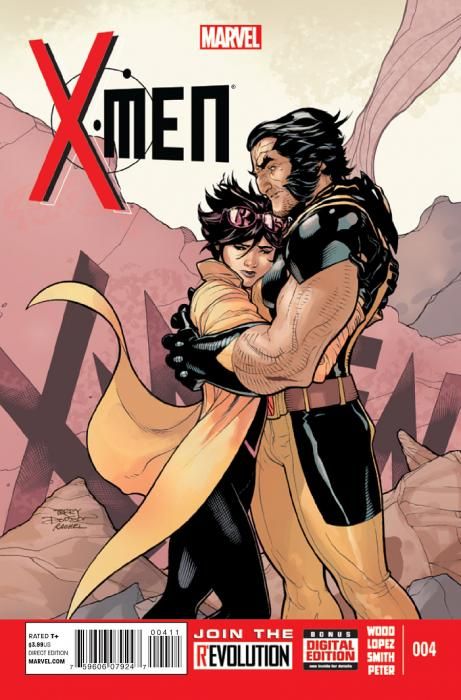"X-Men" #4 by Brian Wood and David Lopez is an issue in which the X-Men recover and regroup, a resting place between the first arc and the upcoming "Battle of the Atom" crossover. These interludes can feel like filler, and unfortunately, "X-Men" #4 is a somewhat aimless issue.
Wood raises two the central conflicts, but neither resolves nor advances either in a satisfying way. The setting alternates between Jubilee, Shogo and Wolverine hanging out peacefully in California, and the rest of the team flying above the Sierra Nevada mountains. Jubilee and Shogo's trip around California with Wolverine is warm and fuzzy, but the bland dialogue, filled with the usual sentiments about family and responsibility, is ultimately forgettable.
The other major plot point is a philosophical schism and power struggle between Storm and Rachel Grey over Storm's decision-making regarding Karima Shapander. While the moral disagreement over the use of lethal force is always relevant to superhero comics, Wood doesn't add anything new philosophically. The leadership struggle has the potential to be juicy, but just ends up being an imitation of the older power struggles and moral differences, most notably the long-standing dislike between Cyclops and Wolverine. Ororo and Rachel's face-off feels stale and tailored to deliberately drive up tension, instead of an organic extension of genuine personality differences. It's nice that their interaction passes the Bechdel test, but it doesn't feel distinctive, natural or electric.
Wood is known for intense, character-focused stories, so it's a surprise that the plot tension in "X-Men" #4 feels loose, and that the action feels predictable, even forced. The dialogue when Storm rescues Rogue is heavy-handed with sentimentality, bordering on trite. The threat that is supposed to be the climax -- one of the X-Men falling into space from an airplane -- is small-peanuts compared to what any of these women have faced alone before, and what results is lack of suspense.
Lopez's artwork doesn't have Coipel's elegant compositions, but his feel for action is solid. There's a lot of movement as five women move around the plane arguing and pulling off acrobatic feats, and Lopez pulls it off. His facial expressions and body language are weaker, though. Jubilee's face doesn't show enough emotion and her extended sequence with Wolverine relies on Wood's chatty slow dialogue for its effects. In the mountains, the facial expressions show a lot of surprise and shock, but they feel slightly overwrought.
Lopez draws intricate background detail in the California scenes, including Jubilee's tattoos, pleasantly crowded interiors and architectural elements, but the mountain scenes are stark and sparse, focusing only on human figures and the plane. Peter colors California in bright warm transparent tones while the Sierra Nevada is dominated by gloomy grays. Thus, both pencils and colors highlight the contrast between California warmth/mountain cold, safety vs. danger. On the positive side, the reader is never lost. However, the visual contrast brings up the question of why these two stories are juxtaposed and interwoven at all. The two situations are only weakly connected by Wood's themes about rescue and family. While the back-and-forth is executed just fine, the events don't feel significant enough to justify why this technique was used.
The best moments of "X-Men" #4 are smaller, like when Kitty and Rogue rib Psylocke about her love life, or Shogo's silly baby facial expressions on the beach or in a restaurant. In upcoming issues of "X-Men," Wood will probably return to a story more like tightly-wound action of the first story arc, but it would be good to see more of this kind of grace and humor as part of his characterization strategy.

